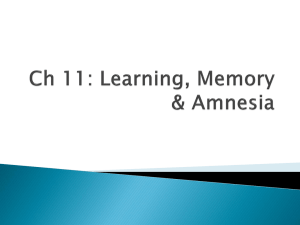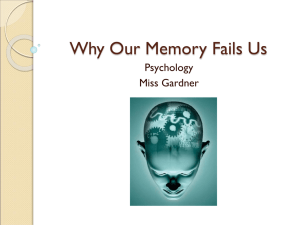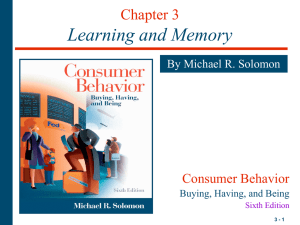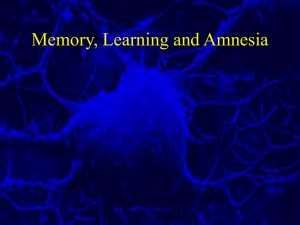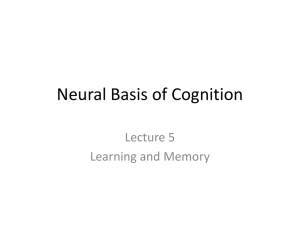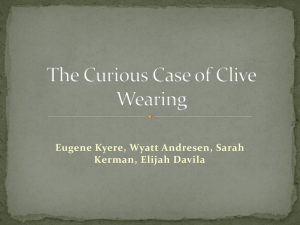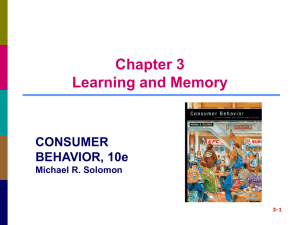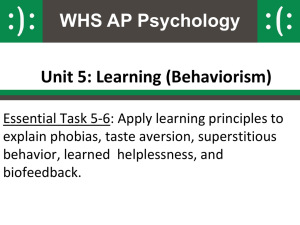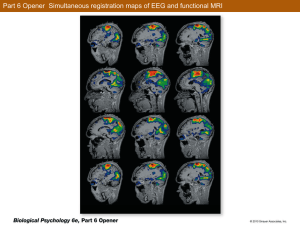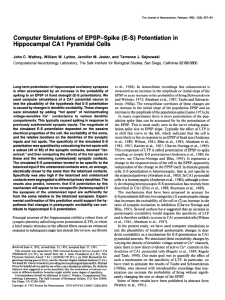Chapter 13
advertisement
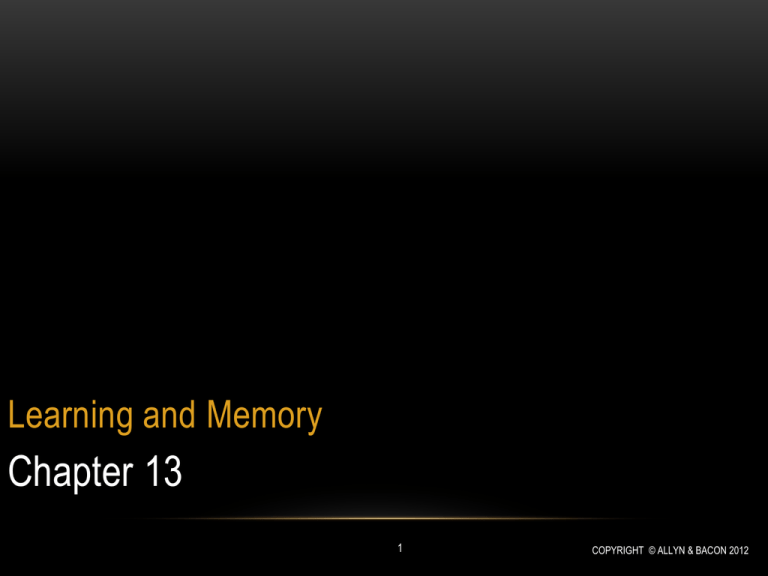
Learning and Memory Chapter 13 1 COPYRIGHT © ALLYN & BACON 2012 The Nature of Learning • Classical conditioning is a form of learning in which an unimportant stimulus acquires the properties of an important one. It involves an association between two stimuli. A stimulus that previously had little effect on behavior becomes able to evoke a reflexive, species-typical behavior. • classical conditioning • A learning procedure; when a stimulus that initially produces no particular response is followed several times by an unconditional stimulus (US) that produces a defensive or appetitive response (the unconditional response—UR), the first stimulus (now called a conditional stimulus—CS) itself evokes the response (now called a conditional response—CR). 2 COPYRIGHT © ALLYN & BACON 2012 3 The Nature of Learning • Hebb rule • The hypothesis proposed by Donald Hebb that the cellular basis of learning involves strengthening of a synapse that is repeatedly active when the postsynaptic neuron fires. • When Hebb formulated his rule, he was unable to determine whether it was true or false. • Now, finally, enough progress has been made in laboratory techniques that the strength of individual synapses can be determined, and investigators are studying the physiological bases of learning. 4 The Nature of Learning • The second major class of stimulus-response learning is instrumental conditioning (also called operant conditioning). • instrumental conditioning • A learning procedure whereby the effects of a particular behavior in a particular situation increase (reinforce) or decrease (punish) the probability of the behavior; also called operant conditioning. • Whereas classical conditioning involves automatic, species-typical responses, instrumental conditioning involves behaviors that have been learned. 5 The Nature of Learning • Collectively, “favorable consequences” are referred to as reinforcing stimuli, and “unfavorable consequences” are referred to as punishing stimuli. • For example, a response that enables a hungry organism to find food will be reinforced, and a response that causes pain will be punished. (Psychologists often refer to these terms as reinforcers and punishers.) • reinforcing stimulus • An appetitive stimulus that follows a particular behavior and thus makes the behavior become more frequent. • punishing stimulus • An aversive stimulus that follows a particular behavior and thus makes the behavior become less frequent. 6 7 Synaptic Plasticity: Long Term Potentiation and Long-Term Depression • Induction of Long-Term Potentiation • Electrical stimulation of circuits within the hippocampal formation can lead to long-term synaptic changes that seem to be among those responsible for learning. • Lømo (1966) discovered that intense electrical stimulation of axons leading from the entorhinal cortex to the dentate gyrus caused a long-term increase in the magnitude of excitatory postsynaptic potentials in the postsynaptic neurons; this increase has come to be called long-term potentiation (LTP). (The word potentiate means “to strengthen, to make more potent.”) • long-term potentiation (LTP) • A long-term increase in the excitability of a neuron to a particular synaptic input caused by repeated high-frequency activity of that input. 8 9 10 11 12 13 14 Synaptic Plasticity: Long Term Potentiation and Long-Term Depression • Role of NMDA Receptors • AP5 • 2-Amino-5-phosphonopentanoate, a drug that blocks NMDA receptors. • These results indicate that the activation of NMDA receptors is necessary for the first step in the process events that establishes LTP: the entry of calcium ions into dendritic spines. 15 16 17 Synaptic Plasticity: Long Term Potentiation and Long-Term Depression • Long-Term Depression • I mentioned earlier that low-frequency stimulation of the synaptic inputs to a cell can decrease rather than increase their strength. • This phenomenon, known as long-term depression (LTD), also plays a role in learning. • long-term depression (LTD) • A long-term decrease in the excitability of a neuron to a particular synaptic input caused by stimulation of the terminal button while the postsynaptic membrane is hyperpolarized or only slightly depolarized. 18 Synaptic Plasticity: Long Term Potentiation and Long-Term Depression • Long-Term Depression • Apparently, neural circuits that contain memories are established by strengthening some synapses and weakening others. • Dudek and Bear (1992) stimulated Schaffer collateral inputs to CA1 neurons in hippocampal slices with 900 pulses of electrical current, delivered at rates ranging from 1 to 50 Hz. • They found that frequencies above 10 Hz caused long-term potentiation, whereas those below 10 Hz caused long-term depression. Both of these effects were blocked by application of AP5, the NMDA receptor blocker; thus, both effects require the activation of NMDA receptors. (See Figure 13.15.) 19 20 Perceptual Learning • Learning to Recognize Stimuli • In mammals with large and complex brains, objects are recognized visually by circuits of neurons in the visual association cortex. • Visual learning can take place very rapidly, and the number of items that can be remembered is enormous. • In fact, Standing (1973) showed people 10,000 color slides and found that they could recognize most of the slides weeks later. • Other primates are capable of remembering items that they have seen for just a few seconds, and the experience changes the responses of neurons in their visual association cortex (Rolls, 1995b). 21 COPYRIGHT © ALLYN & BACON 2012 22 Perceptual Learning • Perceptual Short-Term Memory • delayed matching-to-sample task • A task that requires the subject to indicate which of several stimuli has just been perceived. • Ranganath and his colleagues found that short-term memories of faces activated the fusiform face area and that short-term memories of places activated the parahippocampal place area. 23 24 Instrumental Conditioning • Basal Ganglia • Evidence suggests that as learned behaviors become automatic and routine, they are “transferred” to the basal ganglia. • The process seems to work like this: As we deliberately perform a complex behavior, the basal ganglia receive information about the stimuli that are present and the responses we are making. • At first the basal ganglia are passive “observers” of the situation, but as the behaviors are repeated again and again, the basal ganglia begin to learn what to do. • Eventually, they take over most of the details of the process, leaving the transcortical circuits free to do something else. We need no longer think about what we are doing. 25 26 Instrumental Conditioning • Neural Circuits Involved in Reinforcement • ventral tegmental area (VTA) • A group of dopaminergic neurons in the ventral midbrain whose axons form the mesolimbic and mesocortical systems; plays a critical role in reinforcement. • nucleus accumbens • A nucleus of the basal forebrain near the septum; receives dopamine-secreting terminal buttons from neurons of the ventral tegmental area and is thought to be involved in reinforcement and attention. 27 28 Instrumental Conditioning • Section Summary: Instrumental Conditioning • Olds and Milner discovered that rats would perform a response that caused electrical current to be delivered through an electrode placed in their brain; thus, the stimulation was reinforcing. • Subsequent studies found that stimulation of many locations had reinforcing effects but that the medial forebrain bundle produced the strongest and most reliable ones. 29 30 Relational Learning • Human Anterograde Amnesia • In 1889, Sergei Korsakoff, a Russian physician, first described a severe memory impairment caused by brain damage, and the disorder was given his name. • The most profound symptom of Korsakoff’s syndrome is a severe anterograde amnesia: The patients appear to be unable to form new memories, although they can still remember old ones. • Korsakoff’s syndrome • Permanent anterograde amnesia caused by brain damage resulting from chronic alcoholism or malnutrition. 31 32 Relational Learning • Declarative and Nondeclarative Memories • For example, some investigators (Eichenbaum, Otto, and Cohen, 1992; Squire, 1992) suggest that patients with anterograde amnesia are unable to form declarative memories, which have been defined as those that are “explicitly available to conscious recollection as facts, events, or specific stimuli” (Squire, Shimamura, and Amaral, 1989, p. 218). • declarative memory • Memory that can be verbally expressed, such as memory for events in a person's past. 33 Relational Learning • Declarative and Nondeclarative Memories • The other category of memories, often called nondeclarative memories, includes instances of perceptual, stimulus-response, and motor learning that we are not necessarily conscious of. (Some psychologists refer to these two categories as explicit and implicit memories, respectively.) • nondeclarative memory • Memory whose formation does not depend on the hippocampal formation; a collective term for perceptual, stimulus-response, and motor memory. 34 35 Relational Learning • Anatomy of Anterograde Amnesia • The outputs of the hippocampal system come primarily from field CA1 and the subiculum. • Most of these outputs are relayed back through the entorhinal, perirhinal, and parahippocampal cortex to the same regions of association cortex that provide inputs. • The hippocampal formation also receives input from subcortical regions via the fornix. These inputs select and modulate the functions of the hippocampal formation. 36 Relational Learning • Anatomy of Anterograde Amnesia • The fornix carries dopaminergic axons from the ventral tegmental area, noradrenergic axons from the locus coeruleus, serotonergic axons from the raphe nuclei, and acetylcholinergic axons from the medial septum. • The fornix also connects the hippocampal formation with the mammillary bodies, located in the posterior hypothalamus. • The most prominent brain damage seen in cases of Korsakoff’s syndrome—and presumably the cause of the anterograde amnesia—is degeneration of the mammillary bodies. (See Figure 13.28.) 37 38 39 40 41 Relational Learning • Place Cells in the Hippocampal Formation • A particular neuron might fire twenty times per second when the animal was in a particular location but only a few times per hour when the animal was located elsewhere. • For obvious reasons these neurons were named place cells. • place cell • A neuron that becomes active when the animal is in a particular location in the environment; most typically found in the hippocampal formation. • The red spots indicate the firing of a single hippocampal place cell that, as you can see, fired primarily when the rat was in a particular location (Derdikman and Moser, 2010). (See Figure 13.34.) 42 43 Relational Learning • Reconsolidation of Memories • Memories can be altered or connected to newer memories. • In recent years, researchers have been investigating a phenomenon known as reconsolidation, which appears to involve modification of long-term memories. • reconsolidation • A process of consolidation of a memory that occurs subsequent to the original consolidation that can be triggered by a reminder of the original stimulus; thought to provide the means for modifying existing memories. 44
